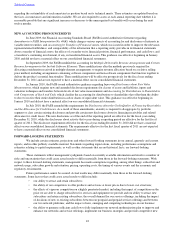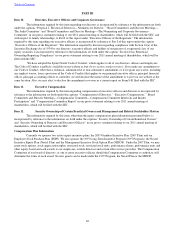Sprint - Nextel 2010 Annual Report Download - page 44
Download and view the complete annual report
Please find page 44 of the 2010 Sprint - Nextel annual report below. You can navigate through the pages in the report by either clicking on the pages listed below, or by using the keyword search tool below to find specific information within the annual report.
regarding the sustainability of each uncertain tax position based on its technical merits. These estimates are updated based on
the facts, circumstances and information available. We are also required to assess at each annual reporting date whether it is
reasonably possible that any significant increases or decreases to the unrecognized tax benefits will occur during the next
twelve months.
NEW ACCOUNTING PRONOUNCEMENTS
In June 2009, the Financial Accounting Standards Board (FASB) issued authoritative literature regarding
Amendments to FASB Interpretation No. 46(R), which changes various aspects of accounting for and disclosures of interests in
variable interest entities, and Accounting for Transfers of Financial Assets, which was issued in order to improve the relevance,
representational faithfulness, and comparability of the information that a reporting entity provides in its financial statements
about a transfer of financial assets; the effects of a transfer on its financial position, financial performance, and cash flows; and
a transferor's continuing involvement, if any, in transferred financial assets. This guidance was effective beginning in January
2010 and did not have a material effect on our consolidated financial statements.
In September 2009, the FASB modified the accounting for Multiple-Deliverable Revenue Arrangements and Certain
Revenue Arrangements that Include Software Elements. These modifications alter the methods previously required for
allocating consideration received in multiple-element arrangements to require revenue allocation based on a relative selling
price method, including arrangements containing software components and non-software components that function together to
deliver the product's essential functionality. These modifications will be effective prospectively for the fiscal year ending
December 31, 2011 and are not expected to have a material effect on our consolidated financial statements.
In January 2010, the FASB issued authoritative guidance regarding Improving Disclosures about Fair Value
Measurements, which requires new and amended disclosure requirements for classes of assets and liabilities, inputs and
valuation techniques and transfers between levels of fair value measurements and Accounting for Distributions to Shareholders
with Components of Stock and Cash, which clarifies the accounting for distributions to shareholders that offer them the ability
to elect to receive their entire distribution in cash or shares of equivalent value. This guidance was effective beginning in
January 2010 and did not have a material effect on our consolidated financial statements.
In July 2010, the FASB amended the requirements for Disclosures about the Credit Quality of Financing Receivables
and the Allowance for Credit Losses. As a result of these amendments, an entity is required to disaggregate by portfolio
segment or class certain existing disclosures and provide certain new disclosures about its financing receivables and related
allowance for credit losses. The new disclosures as of the end of the reporting period are effective for the fiscal year ending
December 31, 2010, while the disclosures about activity that occurs during a reporting period are effective for the first fiscal
quarter of 2011. The disclosure requirements effective for the fiscal year ending December 31, 2010 did not have a material
effect on our consolidated financial statements. The requirements effective for the first fiscal quarter of 2011 are not expected
to have a material effect on our consolidated financial statements.
FORWARD-LOOKING STATEMENTS
We include certain estimates, projections and other forward-looking statements in our annual, quarterly and current
reports, and in other publicly available material. Statements regarding expectations, including performance assumptions and
estimates relating to capital requirements, as well as other statements that are not historical facts, are forward-looking
statements.
These statements reflect management's judgments based on currently available information and involve a number of
risks and uncertainties that could cause actual results to differ materially from those in the forward-looking statements. With
respect to these forward-looking statements, management has made assumptions regarding, among other things, subscriber and
network usage, subscriber growth and retention, pricing, operating costs, the timing of various events and the economic and
regulatory environment.
Future performance cannot be assured. Actual results may differ materially from those in the forward-looking
statements. Some factors that could cause actual results to differ include:
• our ability to attract and retain subscribers;
• the ability of our competitors to offer products and services at lower prices due to lower cost structures;
• the effects of vigorous competition on a highly penetrated market, including the impact of competition on the
price we are able to charge subscribers for services and equipment we provide and our ability to attract new
subscribers and retain existing subscribers; the overall demand for our service offerings, including the impact
of decisions of new or existing subscribers between our postpaid and prepaid services offerings and between
our two network platforms; and the impact of new, emerging and competing technologies on our business;
• the ability to generate sufficient cash flow to fully implement our network modernization plan to improve and
enhance our networks and service offerings, implement our business strategies and provide competitive new
Table of Contents
42
























